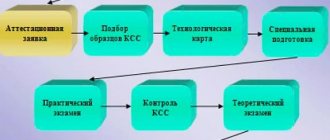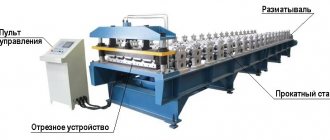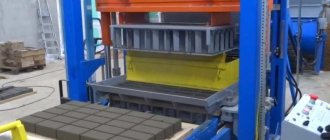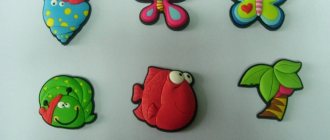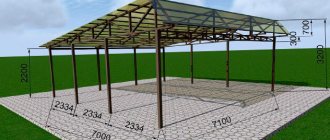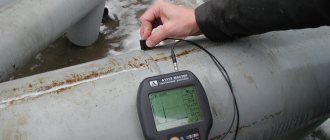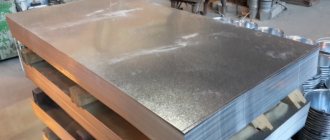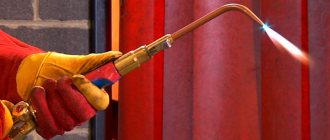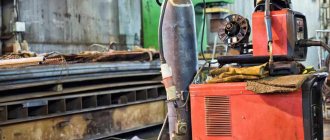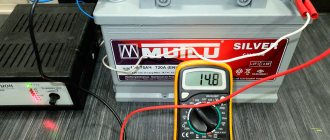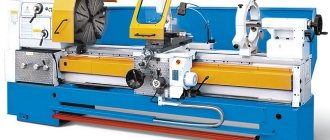Corrugated sheets have been actively used in construction and in many other areas for several decades. This reliable material, the production of which requires a special machine for the production of corrugated sheets, is used as the main element of enclosing structures, it covers the roofs of building structures, cladding walls, and also solves a whole list of other problems associated with both capital and private construction.
Corrugated sheets are produced by cold rolling
The production of profiled sheets can be carried out using both mechanized and manual equipment, which, if desired, can be made with your own hands. Knowing all the nuances of such production, you can organize a profitable business for the production of profiled sheets that are in demand on the market or produce such material for your own needs at minimal cost.
How is corrugated sheet made?
To obtain high-quality material, you need appropriate equipment for corrugated sheeting, so organizing the production of this roofing requires a large initial investment, but its payback time is minimal.
A production line is only possible if the workshops:
- there is a gantry crane or any similar equipment;
- the temperature regime is observed (not lower than +4 degrees);
- Spacious warehouses are equipped for storing steel coils and other finished products.
Depending on the purpose of use, corrugated sheeting may have a special coating, or it may be produced without it. The starting material can be metal for the manufacture of corrugated sheets, which is coated with polymers for external work, and without coating is successfully used in the construction of concrete formwork.
The use of first-grade steel is common - in this case, a zinc coating of 20-26 microns is applied over the profile. If the coating thickness is noticeably reduced, the service life of the material is reduced several times.
Based on this, the production of corrugated sheets requires the use of high-quality raw materials with additional spraying and production equipment from a large company reputable in the mechanical engineering industry.
Coating Forming Equipment
To produce corrugated sheets, professional equipment or homemade machines can be used. According to the technology, at the first stage the metal is passed through rollers, forming a profile. Then the required parameters of the product are cut using guillotine shears.
For production, 3 types of machines are used:
- manual;
- with partial automation;
- automatic lines.
Manual homemade and semi-automatic machine
Manual equipment allows you to produce a product only with a profile of 1 standard size. This is due to the fact that on a machine operated at home, there is no way to adjust the rollers. Metal of small thickness is rolled here. The products are of low quality and are used only as fences or barriers.
You can make such a machine yourself. The operating procedure is as follows:
- A metal frame is made, which is attached to the concrete base using anchor bolts.
- A desktop is installed on top. Its dimensions must exceed the length of the workpiece. It supplies metal to the work area and removes the finished product.
- A strip is attached with bolted connections, which is necessary for fixing the metal roll.
- Using bearings, angles and pipes, equipment tools are made - rollers.
- They are installed on the frame. Pressing is carried out using a lever. Then the workpiece is fed into the working area.
The rollers are made of tool steel with a hardening degree of 54−58 HRC.
When using partially automated equipment, the machine is additionally equipped with an electric motor. The products produced are more professional. At the same time, the machine is mobile due to its low weight. It is easy to carry. It is installed next to the object for which the corrugated sheet is made. This could be low-rise construction, covering for agricultural warehouses or fencing.
Fully automatic lines
An automatic line is a complex of units. Includes the following settings:
- rolling mill with rollers;
- guillotine shears;
- coating equipment.
An electric car is used to transport profiled sheets. The productivity of such lines is several times higher than any equipment and is used in large industries.
Technology for self-production of corrugated sheets (mechanical sheet bending machine)
The profiled sheet is presented in the form of a bent sheet profile with trapezoidal corrugation. To produce such a metal profile, it is rolled using a manual machine called a sheet bender (read: “Manual machine for corrugated sheeting - manufacturing technology, rules of use”). The thickness of the galvanized sheet in this case can be no more than 0.5 mm.
Currently, manual equipment for the production of corrugated sheets is used in piece production or for the production of components - these can be valleys, ridges, cornice strips.
Description of the technical data of the sheet bending machine:
- sheets no more than 2 m long;
- thickness up to 0.5 mm;
- bend no more than 150 degrees.
The work is performed as follows: the sheet is placed on the frame, and a pressure bar is installed on top of it. The lever, when activated, bends the sheet at a certain angle - you can verify the correct execution by comparing the result with what is shown in the photo.
The machine is offered on the market at a relatively low price, but it is not suitable for working with polymer-coated material, as it can quickly fail.
Dimensions of corrugated sheeting of all brands, technical characteristics, types of trapezoids in production
| Profiled sheet C8 For walls, facade, fence
| Profiled sheet C10 For walls, facade, fence
| Profiled sheet S20, MP20 For roofing, walls, facade, fence
|
| Profiled sheet C21 For roofing, walls, facade, fence
| Profiled sheet MP35 For roofing, walls, facade, fence
| Profiled sheeting NS35 For roofing, ceilings, load-bearing
|
| Profiled sheet C44 For roof, facade, walls
| Profiled sheeting NS44 For roofing, ceilings, load-bearing
| Profiled sheet N57 For roofing, ceilings, load-bearing
|
| Profiled sheet N60 For roofing and load-bearing structures
| Profiled sheet N75 For roofing and load-bearing structures
| Profiled sheet N114 For roofing and load-bearing structures
|
Characteristics of industrial corrugated sheet production line
Thanks to the use of cold rolling, the production of corrugated sheets in large volumes with a variety of profile geometries is ensured.
Large manufacturers of profiled sheets use special devices to create a standard production line, each of which performs a specific function:
- The unwinder, due to the installed shaft, firmly fixes and holds the sheet steel in one position;
- the forming mill (the main element of the industrial line) profiles the supplied strip material;
- guillotine shears cut the finished profile sheet into several measured sheets of certain sizes, and at the construction site they use a disk to cut corrugated sheets;
- using a receiving table, the dimensions of which, as a rule, correspond to the profiled sheets produced, finished products are stacked and packaged, which are then sent to the warehouse;
- The control unit turns on and off the equipment for the production of corrugated sheets, and is also responsible for regulating the dimensions of both individual components at each stage and the entire process.
Inside the rolling forming mill there are special stands - pairs of shafts symmetrically installed on the frame. Mechanically compressed stands perform the formation of corrugations (waves). Depending on the number of stands involved in the manufacturing process, the depth of the formed profile is determined. At the same time, the purpose of the mill is not limited to only performing the main technological stages; it also acts as a basic component for the operation of other devices, in particular the guillotine and control system (useful article: “Machine for the production of corrugated sheets”).
An integral stage of the production technology is cutting the material with guillotine shears. The shears operate on a hydraulic, electromechanical or pneumatic drive (the latter option is used in rare cases), their shape must match the geometry of the sheet profile. Using scissors with a clear design, you can be sure of producing the highest quality profiled sheets.
Monitoring the correct functioning of mechanisms and devices is carried out by the control unit. In its settings, you can change the dimensions of the sheet, for example, the thickness of the base material, its length, and type of coating. In many companies, the production line is equipped with an automatic safety system - sensors that stop the system when emergency situations are detected (
Briefly about the use of corrugated sheets, delivery from the factory
Profiled sheet C8 is traditionally considered a facade brand (wall, for fences). It is characterized by the lowest profile height and the same size of a uniform trapezoid on both sides of the sheet. C10 corrugated sheeting is also more of a wall material, but with a different trapezoid shape. In some cases, it can also be used as a roofing covering. However, profiled sheet C10 cannot be mounted on large slopes with low roof slopes. Galvanized corrugated sheets C8 and C10 have the lightest weight and therefore installation of even long sheets is quite simple and quick. You can order C8 corrugated sheets of two meter lengths from the warehouse at the factory - these are warehouse items. Other lengths are produced in production within 2-5 days.
Profiled sheet C20 is the most popular roofing brand, used both in industrial construction and in low-rise cottage construction. This material, with a profile height of 18 mm, has sufficient stiffening ribs while simultaneously ensuring good water drainage from the roof. It is possible to use corrugated sheet C20 for a more universal purpose - both on the roof and as a wall material. Roofing profiled sheet C21 is no less popular brand today. The dimensions of a higher profile of 21 mm and a wide selection of metal thicknesses make it possible to effectively use it on the roofs of industrial and public buildings of large areas. However, unlike profiled sheets NS35 or NS44, it does not have load-bearing functions even at maximum thickness.
NS35 corrugated sheeting is a material with a minimum profile height if you need the corrugated sheeting to perform the load-bearing functions of a wall and roof, or a roof and ceiling at the same time.
The production of corrugated sheeting C21 is possible in two types - roofing (with a roofing groove on each sheet) or facade (the same height and trapezoid shape, but without a roofing groove) and in a metal thickness of up to 0.8 mm.
Profiled sheet N60 and corrugated sheet N75 are the most common design grades for the construction of any load-bearing structures. This product is characterized by the presence on each side of the trapezoid of an additional stiffening rib (seam), which provides load-bearing properties. If you choose to order corrugated sheet N75 750 or corrugated sheet N60 for installation of a roof with load-bearing properties, then you should keep in mind that the working width of the first is 750 mm, and the second is 845 mm. N114 corrugated sheeting is recommended by SNiP to ensure the ceiling or roof structure has maximum rigidity and strength. When producing profiled sheet N114, the factory uses galvanized metal of at least 0.8 thickness. The technical characteristics of such corrugated sheeting and operational properties allow the free use of metal flooring for up to 50 years - 70 years.
Result:
Since the 19th century, corrugated sheets have become one of the most popular building materials. We have everything you need to produce profiled sheets. We make reliable profiled sheets for roofs, facades and fences. Qualified employees and the presence of our own laboratory guarantee quality control of corrugated sheets at every stage of its production. Thanks to our own production, we are able to provide affordable prices for corrugated sheets. Select the desired profiled sheet and order it in our online store.
* Detailed information about warranty periods for products can be obtained on the website metallprofil.ru in the “Documents” section.
Slicing and packaging
Lastly, the sheets are cut to the required length. All dimensions of corrugated sheets depend on the type of profile; the required length of sheets is indicated by the customer.
Our equipment allows us to make sheets of any size in the range from 0.5 to 12 meters.
Modern high-precision equipment allows us to eliminate the “human factor” from production. All necessary parameters for the manufacture of the product are set by the operator in the automatic control system. Highly qualified personnel work in the workshops for the production of corrugated sheets.
The quality of finished products is controlled by quality control department. Before production begins and at the end of the finished product, samples are taken. The input section operator (using electric scissors) takes a sample from the first roll of a new batch and passes it to the quality control inspector. Quality control is also carried out according to GOST.
Modern equipment allows us to eliminate the “human factor” from production.
The finished corrugated sheet is placed on pallets, covered with bubble wrap and secured with metal ties.
After packaging, orders are placed in a warehouse, from where they are then sent to the end consumer.
Corrugated sheets are well suited for roofs, facades and fences.
Passivation and priming
The strip of now galvanized steel is then coated with a chromate conversion coating and preservative oil. This is a type of coating used to passivate steel products. It is needed to make the steel last even longer.
Steel is coated with a special layer of salts and oxides that prevent it from deteriorating.
Next, a primer coating is applied using a special painting machine.
It additionally protects the steel from destruction, providing strong adhesion between the polymer coating and the metal, leveling out defects on it.
The final stage is the application of the polymer.
Profiling
The automated process of manufacturing corrugated sheet steel can be described in a few phrases. The roll is installed on an unwinder, which ensures correct and uniform feeding of the sheet. The end of the sheet is inserted into the forming machine of the rolling mill. The main parameters are entered into the automatic control system, which include the rolling speed and the number of corrugated sheets. After adjusting the parameters, the equipment starts up. The profile on the sheet appears gradually, passing through many shafts. By the end of the rolling line it turns into a full-fledged profiled sheet. After profiling, the product is cut with hydraulic shears according to the required parameters. Produced on high-tech lines and having gone through all stages of strict control, corrugated sheets meet the highest quality standards.
Quality checking
Next comes the quality control stage. This is what is needed to produce reliable corrugated sheets. has its own laboratory. Here they check the impact and bending strength, the hardness of the polymer coating, the adhesion of the coating to steel, the color difference in comparison with the standard, the gloss and thickness of the coating. The work is carried out by experienced and highly qualified employees. Thanks to constant monitoring, our customers can be confident in the quality of our products.
Workplace of a process engineer for conducting tests.
produces profiled sheets with polymer coating (painted and galvanized) and without it (galvanized only). Painted corrugated sheeting is a more aesthetically pleasing material than galvanized sheeting. It is used in various fields of application: from cladding facades to the construction of durable permanent fencing. The decorative layer of coated corrugated sheets protects from external natural influences - sun, rain and snow.
